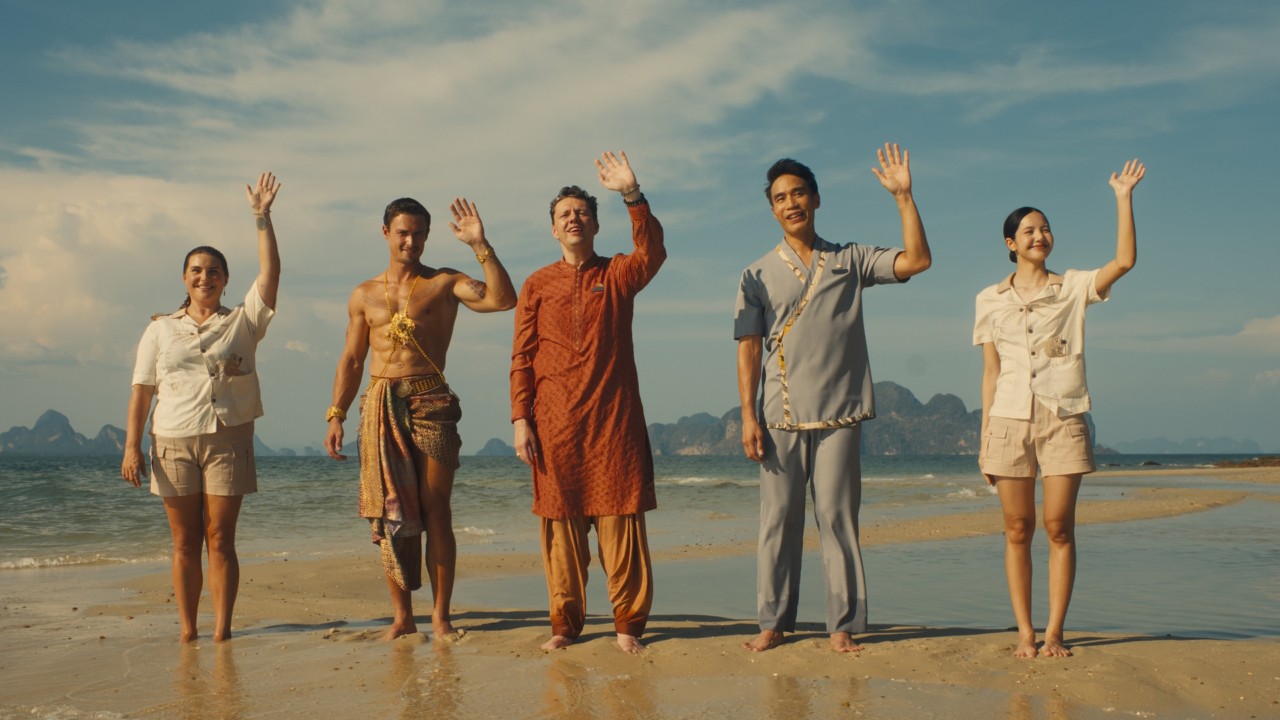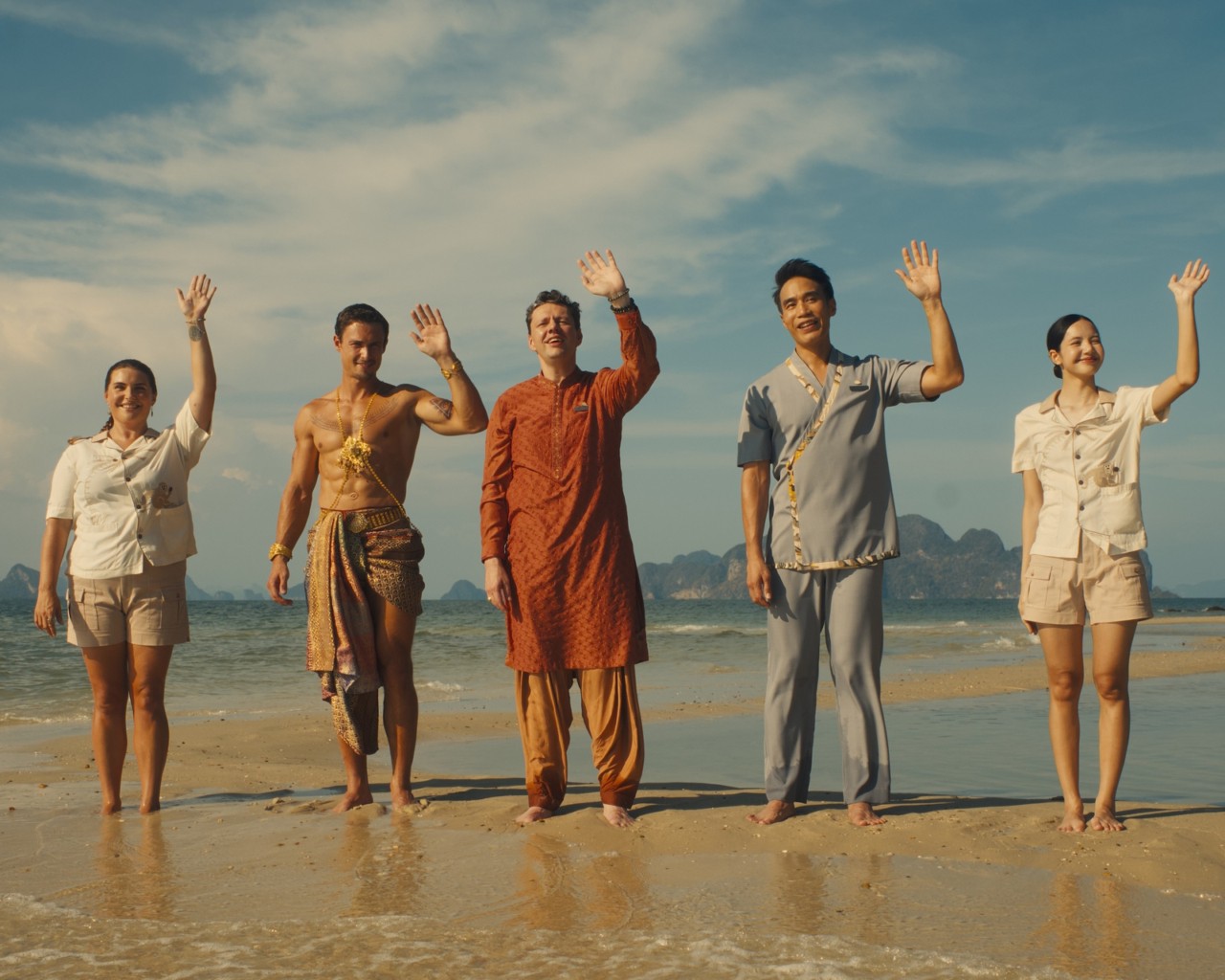

Photograph courtesy of Warner Bros
Words by Billie Walker
Editor’s note: This article contains spoilers for season three of The White Lotus.
The White Lotus, created by Mike White, has dedicated itself to exploring the underbelly of luxury tourism. Each season takes viewers to a different fictional White Lotus resort: first to a posh Hawaiian seaside; then to Sicily’s rocky northeastern coast. In the third iteration of the anthology series, we’re brought to an opulent wellness center on the Thai island of Koh Samui that promises guests a tranquil stay filled with meditation sessions and holistic treatments.
The show’s success hinges on its ability to create tension between its eccentric, privileged guests while hinting at the geo-political conflicts that writhe under the surface of each season’s paradisiacal location.
Thailand in the last several decades became a hotbed for global tourism for visitors of every ilk: from young backpackers and wellness influencers to wealthy vacationers dabbling in both from the comfort of a five-star resort. Tourism on Phuket, an island of around 500,000 residents, ballooned from 3 million visitors in 2003 to 12 million in a decade, according to reporting from Thai media company The Nation.
But Thailand’s popularity as a tropical destination has also brought devastating environmental consequences. The country’s two largest islands, Phuket and Koh Samui—both used for filming the third season of The White Lotus—have experienced high levels of water pollution, depleted marine life, and erosion of coral reefs that all directly correlate to the presence of nearby resorts, hotels, and the boom of beach parties.
Last year, Phuket’s surrounding coral reefs were temporarily closed to tourists to help the underwater ecosystems recover from extensive bleaching. The bleaching, caused by rising sea temperatures, is made worse by nutrient runoff, sedimentation, and pollution from coastal developments like hotels. Meanwhile, Koh Samui is facing a water crisis due to droughts and increased demand, which has intensified since a tourism boom following the pandemic.
Considering the harm real-life versions of White Lotus resorts can cause local ecosystems, how well does the show’s third season succeed in critiquing the lasting damage of such luxury retreats? And is the critique even effective, considering the series’ own “White Lotus effect”? Bookings at the Four Seasons Resort Koh Samui, where much of season three was filmed, had already climbed by 40% days before season three’s first episode even aired, per the New York Times.
“More apparent in this season than the first is the existence of a global Western society, one encroaching on all aspects of the Eastern world, cherry-picking from spiritualist and hedonist practices alike for their own enjoyment.”
Ultimately, the dark dramedy of The White Lotus delights us not for an environmentalist subtext but for the schadenfreude it provides as viewers watch the unfolding drama and ultimate downfall of the 1%. But this year’s season is just as conscientious of the work that goes into running these resorts as its predecessors. Peppered in are scenes of anonymous hotel workers who comb the beaches and mist the tropical fauna at the crack of dawn. These moments hint at the neverending labor that must be done to maintain the illusion of paradise by people working long hours for little pay.
That facade is quickly shattered when a storm hits, reminding residents that the island’s ecosystems exist outside of the resort’s control. In episode three, Lochlan (Sam Nivola), the youngest of the Ratliff family, holds up an iPad featuring a video of a tsunami on a neighboring beach. It’s both prophetic of the father’s incoming business troubles and the inevitable truth that even the wealthiest in society are powerless in the face of extreme weather conditions and a changing climate.
The White Lotus has taken us beyond the classic class divides of an Upstairs, Downstairs-style show, showing further demarcations between the local and international hotel staff. In season one in Maui, many resort employees were American or Australian; but those native to Hawaii, such as Kai (Kekoa Kekumano), were required to participate to entertain guests between dinner service with traditional Hawaiian performances. Tension grew between the Indigenous waiters, whose ancestors once owned the land now designated for rich, international, predominantly white tourists. In season two, the hotel’s staff was made up entirely of Italian members, reflecting the seasonal tourism trade common in southern Europe.
This year some hotel workers are Thai natives, such as Mook (Lalisa Manobal of K-pop girl group, Blackpink) and Gatoook (Tayme Thapthimthong), but many aren’t—particularly those working for the resort’s wellness program.
Early in season three, the difference in attitude toward the surrounding ecosystem becomes clear. Locals are presented as living in harmony with neighboring creatures, while guests are either surprised by or afraid of local animals. After checking into her room, Laurie (Carrie Coon) spots monkeys in the tree next to her balcony. Shocked and excited, she runs next door to tell her friends Kate (Leslie Bibb) and Jaclyn (Michelle Monaghan). “Just don’t feed them,” Kate tells her. “Monkeys can be aggressive.” With the show’s opening scene depicting hotel guests frantically trying to hide or escape from an active shooter, the irony of Kate’s warning is not lost on the viewer: Humans, not monkeys, are the real threat. Later in episode one, when White Lotus staff member Pornchai (Dom Hetrakul) shows Belinda (Natasha Rothwell)—who is on an exchange program in Thailand—around the resort, she screams at the sight of a monitor lizard. “In time, lizards will become your friend,” he replies.
“The show expertly satirizes how American values encroach on countries across the world, and examines how the luxury tourism industry doubles as a form of modern colonialism.”
The choice of resort this season fits the show’s satirical bite perfectly: a posh wellness retreat for the rich that repackages Thai spirituality—predicated on compassion, respect, and meditation—for the self-centered, rich guests to appropriate. The resort’s wellness services have been given the American rebrand to cater exclusively to the expectations of the clientele.
A key attraction for the guests is Valentin (Julian Kostov), the Russian health mentor, who first appears on the beach in a robe, greeting the guests, his ripped torso exposed and covered in Khmer script tattoos. This introduction begins the show’s season-long commentary on the appropriation of Thailand’s spiritual traditions. More apparent in this season than the first is the existence of a global Western society, one encroaching on all aspects of the Eastern world, cherry-picking from spiritualist and hedonist practices alike for their own enjoyment.
Hotel worker Pam (Morgan O’Reilly) explains to the Ratliffs that the resort is a “digital detox” zone, reassuring them that they won’t need their technological distractions as the resort’s personalized wellness plans will ensure they have a “busy schedule.” The plan includes a biometrics test offering each guest insights into their hydration level and fat-to-muscle ratio. Instead of attuning guests to the natural state of their bodies, the metrics turn physical health into comparable numbers that quickly turn competitive—especially between Kate, Laurie, and Jaclyn, who hope to reunite on their girls’ trip but instead return to their cutthroat high school dynamics. Time and again, moments that may hold meditative possibilities are instead filled with terminology more suited to the boardroom than the massage table, exposing the oxymoronic language of a wellness culture co-opted by consumerism.
It isn’t just young tourists and travelers who come to Thailand; it also has a large population of expats, with Fortune Magazine voting the island of Phuket as one of the top retirement destinations. In the show, this population of mainly older white men have been nicknamed LBH—“losers back home”—by the locals. It’s an amusing aside that helps to further paint the picture of Thailand as overwhelmed by wealthy citizens from the Global North who see the country as a retirement village.
Each White Lotus resort on the show highlights its unique destination by deploying curated interior design, employee uniforms, and culinary tweaks. But beyond the palm-frond-themed bedrooms of Hawaii, renaissance mural features of Sicily, and monkey chatter in the Thai resort’s backdrop, one thing remains the same: the guests. The show expertly satirizes how American values encroach on countries across the world, and examines how the luxury tourism industry doubles as a form of modern colonialism.
Though The White Lotus may not overtly focus on the environmental impact of tourism, it does continuously point to a facet of the wealthy elite who treat every country they visit as a personal playground: places of natural beauty from which to extract luxury experiences, with little care for the mess they leave behind—or who is forced to clean up after them.
The High Price of Paradise in ‘The White Lotus’ Season 3